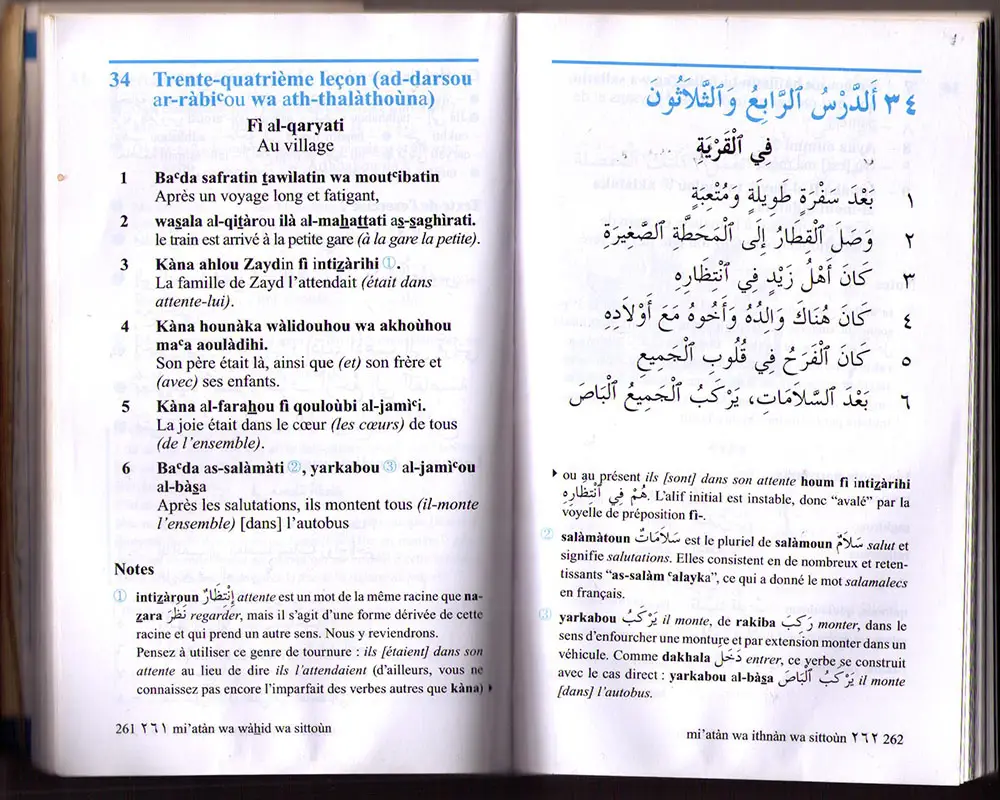Review of Assimil Arabic with ease
Assimil - A review my favorite language course
This Assimil Arabic Review is primarily about the Arabic edition of the Assimil language courses, but many of the points apply to everything in Assimil’s catalogue. (See my review of the French Assimil also)
Assimil is the name of a French company that has published languages courses since 1929.
It all started with a course for French speakers who wanted to learn English. Created by Alphonse Chérel, the original series consisted of a book with bilingual dialogues that gradually got more difficult. Since the beginning, the course has been accompanied by audio recordings. The first edition has since become known for its humorous and sometimes silly jokes and illustrations. To this day, most Frenchmen will know the phrase “My tailor is rich, but my English is poor” that could be found in the original version. Assimil is known for teaching language intuitively, and “without toil”. You’re not supposed to study grammar and do boring drills, but rather to learn through assimilation, and time, as well as the success of the company, has proved that it works!
Assimil continues to publish new language courses to this day. Language guides for close to 100 languages can be found in French, but today they’re published in many other teaching languages too, most importantly for this article, in English.
This article will have a special focus on the “Assimil - Arabic with ease” edition, but the information can be applied to other Assimil courses as well.
How the Assimil method works
Assimil has an intuitive approach, where you primarily learn through passive consumption of the language. You read and listen, but grammar explanations and exercises, although present, are kept at a minimum. The idea is to let your brain assimilate the language naturally, rather that “studying” it.
You might say: “Sure! But I’m serious about learning this language, so I’ll be better of focusing on grammar, exercises and word-for-word translation” - but actually you’d be wrong. Linguists, today, theorize that you acquire a language by consuming it, not by speaking, writing or “filling in the blanks”. These activities are just different types of language performance; you don’t learn this way, you only use what you already know. Many language students, multilinguals and polyglots can testify to the veracity of this theory. So although it not being strictly proven, a lot of things point to the Assimil approach as being the right way to go.
An Assimil guide starts out simple: In the beginning you read short dialogues formed by primarily high frequency words, or, the words that are most commonly used in the language. You read the dialogue on the left page, while listening to the audio recording.
In the Arabic version, the words are spelled out with the Arabic script, as well as in romanization. On the facing page, you’ll find the corresponding text in English as well as a few notes that lightly delve into a few grammar concepts as well as information about the Arabic letters used in the lesson.
The Arabic Assimil has 77 lessons. The course description proposes that you read and listen through one lesson per day until you finish half of the book, then go back to lesson one and start reading it without looking at the translation, actively trying to figure out the meaning, only looking at the facing page for eventual support.
How I use Assimil Arabic
In reality, you need to do much more. I propose that you read seven lessons per day, instead of just one. Just reading through a dialogue one time, is simply not enough and you won’t remember much. The reviewing six additional lessons per day gives you the possibility to consolidate the new vocabulary, but don’t sweat it - you probably still won’t feel as if you have grasped the taught material, and this is normal. The idea is that you will recognize the word once you return to do the active phase, and even though you still don’t know the meaning of the word, recognizing that you’ve seen it before is an important step it in learning it.
I also propose that you once in a while read through all the past lessons that you have done when you have a moment to spare, and that you listen to the audio dialogues as often as possible, both in the background while doing other thing and actively.
Arabic has the added difficulty of the script which Assimil handles by gradually introducing a new letter here and there. I think that this gradual approach works wonders for learning how to read the Arabic script, but I suggest that you, in addition to the other activities you do with Assimil also try and write out the new lesson that you add each day. This will help you, not only in learning the script, but also in reviewing new vocabulary in another way than reading and listening.
Is the vocabulary in Assimil Arabic useful?
The Assimil method is sometimes criticized for using “odd” dialogues about subjects and situations that the learner very rarely will find him or herself in. Some Assimil methods have been known to teach such phrases as “my tailor is rich” or something similar. Assimil’s Arabic edition mostly have dialogues about travel, hotels, restaurants and so on. These are all worthy subjects, if we assume that the learner would like to use his Arabic while traveling, but it also has situational dialogues like “Hassan has bad hearing” and the likes.
In my opinion, criticizing Assimil for teaching the wrong vocabulary, is like assuming that learning stops after Assimil. I guarantee that this is not the case. When you have finished the course, you’ll still be a beginner, and you should really only see Assimil as a “first step” into a language. If you look at it that way, it really doesn’t matter much if you start by learning about travel or sports. Eventually, you’ll have to learn much more than that. The notion of vocabulary that you need versus don’t need, to me, is absurd. You need it all, so the dialogues may as well be entertaining.
As a side note, I’d also like to point out that the book cover says that the method will take you to a B2 level. This is marketing, and I can’t imagine how it could be true. I most certainly wasn’t at an intermediate level when I had finished Assimil, but it was a great step stone into the language.
Learning patterns or “chunks” rather than grammar
Assimil is different from other language courses in that it focuses on pattern learning, rather than single-word vocabulary and dedicated grammar study. This is essential for the distinction between learning a language and assimilating it. Learning is about conscious knowledge and analysis, whereas assimilation is “feeling” what is right and what is wrong. Think about your native language - would you be able to explain the grammar to someone learning the language? Probably not. Assimilation, in fact, is the only way to learn a language. Grammar study is learning about the language.
When you study with Assimil, you’re on your way to recognizing patterns in the language. Which words go together, and in what form. The idea is, that rather than seeing each word as one learning object, you see chunks of the language as an object instead, which means that you get a sense for the relationship between words and the combination of them rather than just knowing a lot of words.
Critique of the Arabic edition and the audio
While surfing the net for information about language learning opinions and experiences, I have come upon some mixed views concerning Assimil’s Arabic with Ease.
The main point of critique is the audio recordings in Arabic. Many people think that the speakers speak too slowly, and in a way that’s much too strained and even exaggerated. I actually agree. The audio somehow takes some of the beauty out of spoken Arabic, and it’s not always a pleasure to listen to.
I am guessing that the voice-actors have taken the “acting” part a little too seriously. They’re playing roles that are supposed to help empathize the meaning. It does archive that effect, but the speech doesn’t sound natural, especially when it is very slow in the beginning. I’d encourage Assimil to give the audio recordings another go, and to try and tone down the acting and the comical relief. Above all, the voices need to be pleasant to listen to. The sound files wether on the mp3’s or on the CDs are still very useful, however, and I couldn’t imagine studying without them.
Assimil has made three audio recordings available, so I’m taking the liberty of posting them here.
Another point that people criticize is the choice of words and vocabulary.
Sometimes, the authors have sacrificed realism in order to archive something else, like when a dialogue says “assalamou aleiKA” (peace be upon you in singular) rather than “assalamou aleiKUM” (plural). This choice is no doubt made to illustrate the use of singular, but it is done by formatting the common greeting that everybody uses into something else. This can be a little confusing, but it is still grammatically correct, although a little strange, and it doesn’t really matter in terms of usefulness.
Then there’s the question of grammar. As stated earlier, Assimil doesn’t usually teach a lot of grammar, but the Arabic version does have significantly more explanations that what you normally see. Part of it is due to the Arabic language being highly rational. It makes sense to explain some of the inner workings of Arabic, for it is really quite complicated structurally. Then there’s the preferences and choices of the authors. Personally, I enjoyed reading about some of the grammar explanations, but I didn’t worry too much about them. The Assimil approach is all about learning from context, so I take the grammar notes with a grain of salt, and I advice you to do the same. Read them, by all means. But don’t worry too much if you don’t understand or remember.
Step-by-step method for studying with Assimil
“Passive” wave
- Read the lesson in English, then in Arabic while listening to the audio. Repeat a couple of times.
- Read the notes and a grammar. Try finding examples of the explanations in the Arabic text.
- Write the Arabic text by hand, sounding out what you write. Look at the printed Arabic text as much as you must.In your everyday life, try listening a lot to the audio lessons both actively, and passively while you’re doing other things. Also do pick up the book and read through past lessons as often as you can.When you finish lesson 50, it is time to start the Active wave.
“Active” wave
- Go back to lesson 1. Read the Arabic text, and listen to the recording without looking at the translation. Try and figure out what it means. Check the translation only when you really don’t know.
- Read through the text a second time, but in the version without the tashkeel (vowel diacritic marks) - try sounding out the words, and check with the audio version afterwards if you got the pronunciation right.
This concludes my guide and review for Assimil’s Arabic with Ease
I’d love to hear what you think. Do you already use Assimil? Why, why not? Is there anything that you think I should dig deeper into in my review or something you don’t agree with? Let me know by leaving me a comment below!


